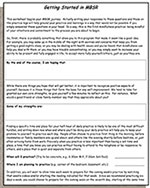Before You Begin...
It's important to consider what it is that you hope will happen as a result of doing this program. For example, you may hope for some effective ways of dealing with stress or worry, ways to cope with illness or difficult life situations, better concentration, an increase in the ability to be present and fully engaged in life, or to accept yourself more fully and others just as they are. What is it that you hope will happen as a result of following this program?
The Getting Started Worksheet will help you answer this question and will create the foundation for your practice over the next eight weeks. Please complete the worksheet now (if you will be completing this by hand, print the PDF version of the Worksheet, but if you'd like to complete it on your computer, download the WORD version).
Take your time in doing this. This is especially important because it is difficult to begin a meditation practice on your own and you will greatly increase your odds of staying with this if you are clear about your goals and when and where you will do the practices.
If you'd like some company on this journey
Although this is a self-paced course, you don't have to do it alone. As you go through the course, there are a number of ways you can interact with other students and past graduates.
One option is to participate in one of the weekly Zoom Meditation & Discussion Meetings. After a short introduction, there is a live group meditation, followed by an opportunity to share real-time with other Palouse Mindfulness students and graduates. One of the six formal practices for a given "week" can be one of these live group meditations, providing a way for you to have a regular weekly group to meet with while you take the course. Attending a regular live meeting is a great way to reinforce your progress through the course and to be part of a vibrant and active community of fellow students and graduates.
Another option is the Palouse Mindfulness Facebook group, an online group in which you will be able to interact with others and get questions answered by graduates of the course (and occasionally, me, Dave Potter). Most questions get answered within an hour or two. Joining is optional, with no requirement that you even make a single post to the group - you could just stay on the sidelines and see what others are saying about their experience with the course.
Frequently Asked Questions
Whether or not you choose to join one of the Palouse Mindfulness forums, be sure to look at the FAQ page, where the most common questions and concerns about the course and the practices are addressed. One of the most common questions is: "Can I take longer than eight weeks to complete the course?". The short answer is an unequivocal "Yes". You can consider yourself ready to go to the next "week" after you have done six practices (and the videos and reading), and it's fine to stay for longer.
Creating a Manual
We suggest that you keep a binder with materials from the course for reference and review. By the time the course is over, if you print the instructions for each week as well each of the documents listed under "Reading" for that week, you will have created your own MBSR manual. If this is something you'd like to do, see MBSR Manual for suggestions about content and organization, as well as documents for the binder cover and table of contents.
Videos and Reading
For each week of the course, under Videos, are a set of presentations related to that week's material by master teachers of mindfulness. Under Reading are articles, formatted for easy reading and ready to be printed for your manual. If you are so inclined, you may also want to keep a "Mindfulness Journal" to write your impressions in a more free-form manner than just the worksheets and practice sheets allow.
Plan to spend about 2 hours a week for the videos and readings. Many people choose a specific day of the week and specific time to watch the videos and do the reading at one sitting (for example, Sunday at 7pm). You can, of course, spread the readings and videos out during the "week". The readings and the videos in the "Supplementary materials" section are entirely optional.
Daily Practice
Your Formal Practice will take about 30-35 minutes each day. Each week introduces a new practice for which you can find the audio through the menu just to the left of this text under "Practices" (on a smartphone, click on the menu icon just under "Palouse" on the top banner). Each week, you will print or download a Formal Practice sheet which you will use to log at least six formal practices before going on to the next week. [NOTE: For one of your six practices, you may substitute the meditation that is part of one of the meetings listed in the Zoom Meditation & Discussion Meetings.]
In addition, there is Informal Practice each day, which will help you integrate the learnings and practices into your daily life. Unlike the formal practice, you don't have to schedule the Informal Practice; it's simply having an intention to bring a special awareness into some of the activities that you already do on a daily basis. At the end of each day, you will log your informal practice, using that week's Informal Practice sheet as a guide. Although the Informal Practice may look less important than the formal practice, it is through the Informal Practice that you will see and realize the concrete and natural benefits of MBSR.
The One-day Retreat
In a live MBSR course, the one-day retreat is held between weeks 6 and 7, but in the Palouse Mindfulness course we offer the retreat after the 8th "week". Palouse Mindfulness students who have successfully completed the body of the course (see Requesting a Certificate) will receive a coupon allowing them to participate in a one-day live online MBSR retreat, led by a qualified MBSR instructor, at no cost. This is possible thanks to the generosity of Mindful Leader, and through a special collaboration with Palouse Mindfulness. These retreats include participants from Mindful Leader's live MBSR courses as well as other Palouse Mindfulness graduates. NOTE: Although we encourage students to attend the full-day retreat, this is not a requirement for receiving a certificate of completion.
Time Commitment
The daily practices plus the videos and readings average about one hour a day. The videos and readings can be done all at once at the beginning of a "Week" or you can spread them out through the week. The total time to do complete the course is around 50 hours over a period of eight "weeks" (see Calculation of course hours). As mentioned above, feel free to take more than a week for any given "Week".
Take whatever time you need for any of the "Weeks"...
To be consistent with a traditional live MBSR course, the segments of the course are called "Weeks", but a key advantage of taking this self-paced version is that you can take as long as you want or need for for any given "Week". If there are interruptions to your progress through the course and you miss a few days, you can safely continue from where you left off (or a little before if it was a long interruption). Once you have done at least six days of practice (not necessarily in a row) and feel that you've gotten the essence of that "week", you may continue to the next "Week". The only suggestion we make time-wise is to not try to do any "Week" in less than seven days.
Health Considerations
Many people come to the course with some physical limitations and it's important that you know that you are free to modify any of the practices, especially the yoga sequences, to make them best work for you. Being aware of your own limits, and modifying the practices when necessary is, in itself, mindfulness in action.
Also, during the course of this program, whether you have physical limitations or not, it is possible, even likely, that difficult feelings or unpleasant memories may arise. Since this program is done without interaction with an instructor, it is important that you take care of your own emotional and mental health. If you are under a counselor or doctor's care already, please let them know of your plan to go through this program, and keep them informed of your experience as you go along, so that they may monitor any unexpected reactions to the course or practices.
If things come up which are too difficult to handle, you should take a break from the course and seek the help of a good counselor or therapist (see If You React Strongly for guidance about whether to take a break or not). If you should need immediate help, dial 911 or 988 (see Crisis Hotlines).
Ready to start?
Once you've completed the Getting Started Worksheet you're ready to go!
Click Week 1 to begin your journey!
Tap Week 1 to begin your journey!
NOTE: You can always find the links for all eight weeks and the audio for the guided meditations by tapping the "three-bar" menu icon under "Palouse" at the top of the page.




